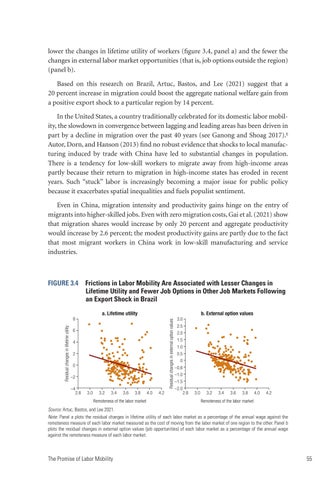lower the changes in lifetime utility of workers (figure 3.4, panel a) and the fewer the changes in external labor market opportunities (that is, job options outside the region) (panel b). Based on this research on Brazil, Artuc, Bastos, and Lee (2021) suggest that a 20 percent increase in migration could boost the aggregate national welfare gain from a positive export shock to a particular region by 14 percent. In the United States, a country traditionally celebrated for its domestic labor mobility, the slowdown in convergence between lagging and leading areas has been driven in part by a decline in migration over the past 40 years (see Ganong and Shoag 2017).6 Autor, Dorn, and Hanson (2013) find no robust evidence that shocks to local manufacturing induced by trade with China have led to substantial changes in population. There is a tendency for low-skill workers to migrate away from high-income areas partly because their return to migration in high-income states has eroded in recent years. Such “stuck” labor is increasingly becoming a major issue for public policy because it exacerbates spatial inequalities and fuels populist sentiment. Even in China, migration intensity and productivity gains hinge on the entry of migrants into higher-skilled jobs. Even with zero migration costs, Gai et al. (2021) show that migration shares would increase by only 20 percent and aggregate productivity would increase by 2.6 percent; the modest productivity gains are partly due to the fact that most migrant workers in China work in low-skill manufacturing and service industries.
FIGURE 3.4
Frictions in Labor Mobility Are Associated with Lesser Changes in Lifetime Utility and Fewer Job Options in Other Job Markets Following an Export Shock in Brazil a. Lifetime utility
b. External option values Residual changes in external option values
Residual changes in lifetime utility
8 6 4 2 0 –2 –4
2.8
3.0
3.2
3.4
3.6
3.8
Remoteness of the labor market
4.0
4.2
3.0 2.5 2.0 1.5 1.0 0.5 0 –0.6 –1.0 –1.5 –2.0
2.8
3.0
3.2
3.4
3.6
3.8
4.0
4.2
Remoteness of the labor market
Source: Artuc, Bastos, and Lee 2021. Note: Panel a plots the residual changes in lifetime utility of each labor market as a percentage of the annual wage against the remoteness measure of each labor market measured as the cost of moving from the labor market of one region to the other. Panel b plots the residual changes in external option values (job opportunities) of each labor market as a percentage of the annual wage against the remoteness measure of each labor market.
The Promise of Labor Mobility
55

